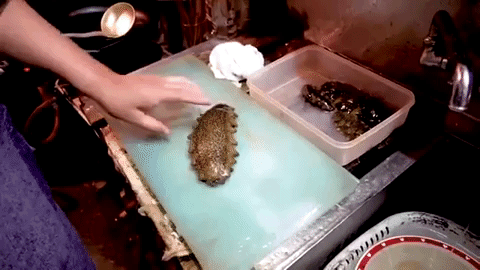Sea cucumbers are marine invertebrates that live on the seafloor. They are named for their unusual oblong shape that resembles a fat cucumber. Although people occasionally eat sea cucumbers, these chubby, worm-like sea creatures aren’t related to their namesake fruit and they wouldn’t make a very appetizing salad topping if you were expecting a crunchy, refreshing bite. But Sea cucumbers cost over $3,000 a kilo, where Cucumbers usually cost under $3 a kilo. In fact, they are so valuable people will risk their lives to get ahold of one. They might not look it, but sea cucumbers are pretty special creatures.
There are about 1,250 species of sea cucumber, all of which belong to the taxonomic class Holothuroidea. This class falls under the Echinodermata phylum, which also includes many other well-known marine invertebrates, such as sea stars, sea urchins and sand dollars.
Sea cucumbers range in size from about three-quarters of an inch (1.9 centimetres) to more than 6 feet long (1.8 meters) and live throughout the world’s oceans, from nearshore shallow waters to the ocean’s deepest trenches. No matter the depth, their main residence is on the ocean floor, often partially buried in the sand.
Sea cucumbers, like all other echinoderms, exhibit radial symmetry. But instead of having five arms arranged in a circle like sea stars or sand dollars, sea cucumbers have five rows of tiny feet that run lengthwise down their bodies, from mouth to anus. Their tube-shaped feet serve mainly to anchor the limbless creatures to the seafloor. Sea cucumbers move across the seafloor by changing the water pressure in their feet; they increase the amount of water in their feet to stretch them out and release the water to contract them.
As the creatures slowly meander about, they use the extra 20 to 30 little tube feet around their mouths to shovel everything in, including sand. They feed primarily on tiny pieces of algae and marine creatures, which get broken down into smaller and smaller pieces, similar to how earthworms break down organic matter in gardens. The sand that the sea cucumbers ingest passes straight through their system and comes out the other end in the form of a sandy poop log.
Along with the sand, sea cucumbers excrete byproducts that benefit ocean ecosystems, particularly coral reefs. A 2011 study published in the Journal of Geophysical Research found that sea cucumbers’ natural digestion process gives their waste products a relatively high (or basic) pH, which means the water surrounding sea cucumber habitats is somewhat protected from ocean acidification. Sea cucumbers also excrete calcium carbonate, which is a primary ingredient in coral formation, and ammonia, which acts as a fertilizer and promotes coral growth.
These otherworldly animals have been prized as a delicacy in Asia for centuries, where the wealthiest class would eat the animals as a nutritious high-protein treat. But it wasn’t until the 1980s that demand exploded. A growing middle class in China meant more people could afford the luxury. Today, they’re typically dried and packaged in ornate boxes, then given as gifts and served on special occasions. So, the fancier and more unusual-looking, the better. And more expensive.
The Japanese sea cucumber at up to $3,500 a kilo, it’s the most expensive sea cucumber on the market. Compared to other varieties, like the Golden Sandfish, Dragonfish, and Curry Fish. And even if you order a common species on Amazon, you could still pay over $170 for a plate. Besides presentation, cucumber connoisseurs also value thick, chewy bodies and to a lesser extent, taste.
But the experience of eating them is only part of their appeal. Turns out sea cucumbers contain high levels of a chemical called fucosylated glycosaminoglycan in their skin, which people across Asia have been using to treat joint problems like arthritis for centuries and more recently in Europe, where people are using it to treat certain cancers and to reduce blood clots.
The sea cucumber craze now comes from all sides. You have the original Asian delicacy demand that started in the 1980s, and the new interest from Western pharmaceutical companies. In response, nations have clamoured to harvest their local species. From Morocco to the United States to Papua New Guinea, everyone wants in on the sea cucumber trade.
For example, from 1996 to 2011, the number of countries exporting sea cucumbers exploded from 35 to 83. But unfortunately, sea cucumbers couldn’t handle the strain. In Yucatan, Mexico, for example, divers saw a 95% drop in their harvest just between 2012 and 2014, and that’s a problem for everyone.
For one, because the more sea cucumbers are harvested, the rarer and more expensive they become. Average prices rose almost 17% worldwide between 2011 and 2016. And the rarer these animals get, the deeper divers are swimming to find them. That’s when fishing gets dangerous.
So far, at least 40 Yucatan divers have died trying to harvest sea cucumbers. And as demand continues to increase, the problem is only getting worse. Of the 70 or more species of exploited sea cucumbers, 7 are now classified as endangered, all through exploitation, forcing numerous fisheries worldwide to shut down and damaging local economies in the process.
So, why not farm sea cucumbers and leave the wild ones alone? Well, it’s easier said than done, since many larvae die before reaching maturity and those that do survive take two to six years to grow to a marketable size. That said, aquaculture for a few varieties has started to take off. Like with that fancy Japanese sea cucumber.
Hopefully, more species will be farmed instead of fished in the future, if not to protect local economies and help develop potentially life-saving drugs, then at least to preserve a fascinatingly bizarre animal.

